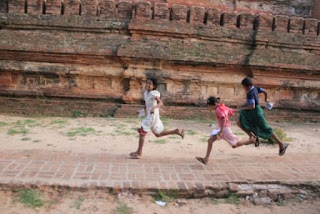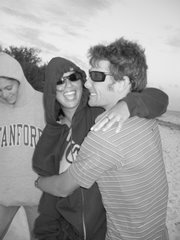It took 2 months to get our visas, but Nikki and I were finally able to visit Burma (Myanmar) with our friends Sam and Alex over labor day weekend. We took a whirlwind tour of three places over four days – Yangon (formally Rangoon), Bagan, and Mandalay. For a variety of reasons, including increased chances of getting our visas, we arranged our travel through a tour company. One downside of this approach is that we had less control over how our money was spent (i.e., harder to avoid government-owned businesses). On the plus side, our guide (who went by "James" for our benefit) was absolutely fantastic.
The biggest attraction in Yangon is the Shwedagon pagoda, which is gold-covered and topped with a 76 carat diamond (among other precious gems). You can see Shwedagon from virtually anywhere in the city and the complex around it was huge – surrounded by many smaller stupas and buildings which are impressive in their own right. Most pagodas are surrounded by "planetary posts" where one prays according to the day of the week you were born. Nikki (Thursday) was represented by Jupiter (and a mouse) while I was represented by Venus and a guinea pig (for Friday). Yangon has many other sights as well – we visited a massive reclining Buddha as well as the Royal Lake with pretty views. Alex and I took an evening walk though the historic downtown with its mish-mash of pagodas, colonial style and modern buildings while the ladies got massages, before we all headed to dinner in a building once used by General Aung San (who led the country to independence in 1948).
The next morning we hopped on a plane to Bagan. Even as we landed you could see hundreds of temples scattered on the broad, dry plain. To me, Bagan is as impressive as the temples of Angkor in terms of sheer scale. 2,000 temples (many 1,000 years old) dot the landscape, housing ancient paintings, scripts, and of course Buddha statues. We had time to visit only a handful of sights – Shwezigon Paya with its fat gold stupa, Ananda Pahto with its beautiful architecture, Manuha with its huge Buddhas in tiny enclosures, Nan Paya with its carvings, and Gubyaukgyi with its 900 year old paintings. In addition to seeing the temples, we visited a local market (where I was able to buy a longyi – a very practical piece of clothing resembling a dress), and a laquerware store/factory in Myinkaba. As the sun set, we climbed the Shwesandaw Paya for stunning views of the area, watching as horsecarts carried tourists across agricultural fields between the temples. Alex and I lingered at the top until the last possible moment, clambering down in the dark. We had breakfast the next morning at our incredible hotel overlooking the Irrawaddy River in Old Bagan. However, it was sobering to discover that the tranquil scene we enjoyed was made possible because the government had forcibly removed the local population from Old Bagan in the late 80's to make way for hotels like ours – yet another reminder of the country's underlying issues. We rushed off to the airport again for the last city on our itinerary – Mandalay.
Mandalay is one of those exotic-sounding places that everyone associates with the far east, but no one really knows much about. It turns out that the area around Mandalay hosted several capitals of the Burmese empire, before the British took the city in 1885. We started out at one of these ancient capitals, Amarapura, where we visited a monastery where 400 monks were enjoying their mid-day meal in silence (one of two meals they get each day). Next, we walked nearly a mile along U Bein's bridge, which is 200 years old and made of teak. After a boat ride back, James had arranged for us to try toddy – a mildly alcoholic beverage made by letting palm juice sit around and ferment for several hours…delicious with fried baby fish and shrimp! After a quick stop at a silk factory, we continued to Mandalay proper to visit the Mahamuni Paya, where I joined the devout in adding to the 6 inches of gold leaf on a massive Buddha. The temple also has a half dozen statues of Vishnu and other deities stolen from Angkor Wat (and transferred via conquest to Mandalay by way of the Thais and two different Burmese empires). After James treated us to a delicious local-style lunch, we visited Shwenandaw Kyaung, one of the original intricately-carved wooden buildings from the royal palace which survived fires and bombing of Allied Forces in World War II, when Japanese soldiers occupied Mandalay. The royal city still exists, but was rebuilt by the government using forced labor, so we avoided this stop. We rounded out the afternoon with a visit to Kuthodaw Paya, which houses the world's longest "book" – actually hundreds of carved stone tablets each housed in a small white pagoda recounting teachings of the Buddha.
At sunset, we climbed Mandalay hill for yet another spectacular view of the surrounding countryside. We relaxed, snapped some photos, and made friends with a couple monks and a girl selling postcards (the one above sporting thanakha, traditional face-paint/sunblock worn by many people in Burma). We relaxed in the swanky hotel bar for a couple hours before piling into a tiny truck/taxi to see the nightly performance of the "Moustache Brothers." This bizarre comedy/dance/variety show troupe performs from their garage in Mandalay, a scaled-down venue after two of the brothers were jailed and subjected to 5 years of hard labor for telling politically tinged jokes. The brothers are out of jail, but still blacklisted and seemed to avoid topics that were too contentious.
We flew back to Yangon for our last day and toured the downtown for a few hours, starting out at the golden pagoda at Sule Paya and walking past city hall, the high court, and various other colonial style buildings. Monsoonal rains hit just as we arrived at the waterfront, resulting in a soggy tour of the comings and goings of the port. We had just enough time to pick up a Burmese rock CD (Ironcross is apparently the most popular group) as well as a Burmese cookbook at a street stall with unbelievable diversity in books – from fluid dynamics to Nietzsche. On our way to the airport, we had just enough time to see a very sad white (albino) elephant exhibit and drive past the house of Aung San Suu Kyi, a political prisoner who has been under house arrest on and off since 1989 (she was released last year and just provided a rare interview in Burmese media).
The trip overall was fantastic and I'm glad we went. Burmese people are incredibly friendly, amazingly knowledgeable about world events (one of our waiters inquired about the status of hurricane Irene), and eager to talk. Burma has sights unlike anywhere else that we have visited in Southeast Asia so far. We took many more pictures that I can post here – there are more on Picasa at: https://picasaweb.google.com/115993796619952960910/Burma. There are definitely problems as well, which we were constantly reminded of as we traveled around the country and learned some of the history. Through it all, the Burmese people seem cautiously optimistic. Hopefully, the coming years will bring more stability for these wonderful people that have endured much.
Wednesday, September 7, 2011
Subscribe to:
Posts (Atom)
































